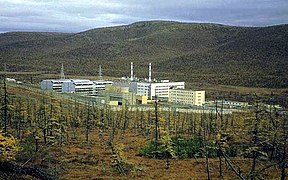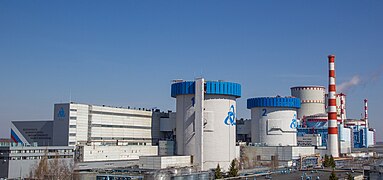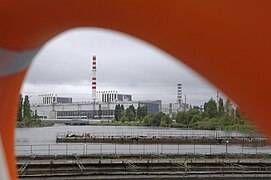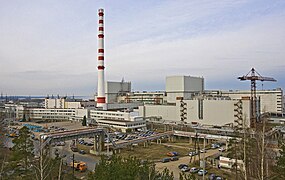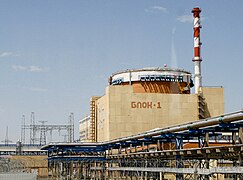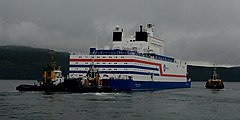Rosatom
 | |
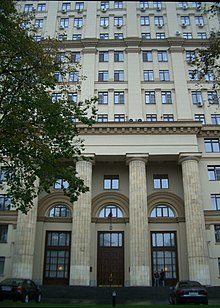 Rosatom's headquarters at Bolshaya Ordynka Street in Moscow | |
Native name | Государственная корпорация по атомной энергии «Росатом» |
|---|---|
| Company type | State corporation |
| Industry | Nuclear power Hydrogen fuel |
| Predecessor | Federal Agency on Atomic Energy |
| Founded | 1 December 2007[1] |
| Founder | Vladimir Putin by signed law[2] |
| Headquarters | , |
Area served | Worldwide |
Key people | Alexey Likhachev(General Director) |
| Products | Nuclear reactors Nuclear fuel |
| Revenue | ₽1,207.4 trillion[3] (2020) |
| Total assets | ₽4,722.4 trillion[3] (2020) |
Number of employees | 276,100[3] (2020) |
| Subsidiaries | See organization |
| Website | rosatom |
Rosatom, (Russian: Росатом, romanized: Rosatom, IPA: [rɐsˈatəm]) stylized as ROSATOM and also known as the Rosatom State Nuclear Energy Corporation, the State Atomic Energy Corporation Rosatom, or the Rosatom State Corporation, is a Russian state corporation headquartered in Moscow that specializes in nuclear energy, nuclear non-energy goods and high-tech products. Established in 2007, the organization comprises more than 350 enterprises, including scientific research organizations, the nuclear weapons complex, and the world's only nuclear icebreaker fleet.[4]
The state corporation is one of the largest in the world's nuclear energy industry. The organization ranks first as the largest electricity generating company in Russia, producing 215.746 TWh of electricity, 20.28% of the country’s total electricity production. The corporation also ranks first in the overseas NPP construction, responsible for 76% of global nuclear technology exports: 35 nuclear power plant units, at different stages of development, in 12 countries, as of December 2020.[5] Rosatom also manufactures equipment and produces isotopes for nuclear medicine, carries out research, material studies; it also produces supercomputers and software as well as different nuclear and non-nuclear innovative products. Rosatom’s strategy is to further develop renewable energy and wind power. Two units are being built in Russia at Kursk-2 NPP with plans announced for 2 more units at Kola NPP.[6] Rosatom with its 38% world market share, in 2019, takes the lead in global uranium enrichment services (36%) and covers 16% of the global nuclear fuel market.[7][non-primary source needed]
In 2020, Rosatom approved its updated strategy emphasizing the role of new products, both nuclear non-energy and non-nuclear, in approximately 100 new business areas, including nuclear medicine, composites, wind energy, hydrogen, waste management, additive technology, production of hydrogen.[3]
Rosatom is a nonprofit organization, and while its tasks include the development of nuclear energy, the growth of enterprises of the nuclear fuel cycle, and the fulfillment of the functions assigned to it by the state, it also ensures national security (nuclear deterrence), nuclear and radiation safety, as well as development of applied and fundamental science. In addition, the state corporation is authorized on behalf of the state to fulfill Russia's international obligations in the field of the use of nuclear energy and of non-proliferation of nuclear materials. Rosatom is also involved with large-scale projects such as ITER and FAIR.
As of February 2021, the total portfolio orders of Rosatom reached $250 billion.[8][9] According to the 2020 corporate report, its 10-year foreign order portfolio stood at $138.3 billion, while revenue reached $7.5 billion. The 10-year order portfolio for new products stood at ₽1,602.1 billion while revenue reached ₽261.1 billion.[10][11]
History
Several Soviet and Russian government entities with different tasks are among the Rosatom predecessors. On June 26, 1953, the Council of Ministers transformed the First Main Directorate in charge of nuclear weapons program into the Ministry of Medium Machine Building (MinSredMash). The ministry was entrusted with the development of the civic nuclear power program. In 1989, Minsredmash and the Ministry of Atomic Energy merged to form the Ministry of Nuclear Engineering and Industry of the USSR.[12][13]
The Ministry for Atomic Energy of the Russian Federation [(Russian: Министерство по атомной энергии Российской Федерации, also known as Minatom (Russian: Минaтом)] was established as a successor to the Russian part of the Ministry of Nuclear Engineering and Industry of the USSR on January 29, 1992 after the dissolution of the Soviet Union. The newly created ministry received about 80% of the enterprises of the union department, including 9 nuclear power plants with 28 power units. Under this name, the ministry existed until March 9, 2004, when it was transformed into the Federal Agency on Atomic Energy.[12][13]
On 1 December 2007, Russian President Vladimir Putin signed a law adopted by the Federal Assembly under which the Federal Atomic Energy Agency were to be abolished, and its powers and assets were to be transferred to the newly created "State Atomic Energy Corporation Rosatom." On 12 December of the same year, the agency transformed into a state corporation.[12][14]
On 20 August 2020, Rosatom marked the 75th anniversary of the Russian nuclear industry. As part of the celebration, Rosatom launched its rebranding campaign “United Rosatom,” which made subsidiaries in the nuclear industry utilize the Rosatom's Moebius strip logo. In 2020, Rosatom set a goal of tripling its revenue to ₽4 trillion by 2030, 40% of which is set to come from new lines of business, with primarily focus on sustainable tech.[15][16][17]
Organization
Rosatom operates about 400 companies, which employ over 250,000 people.[18] The main company structure is:
As of early 2021, Rosatom included 356 of various organizational and legal forms. Some belong to the enterprises of the nuclear power complex, which comprise of organizations of nuclear energy, nuclear engineering, and the nuclear fuel cycle, including enterprises for the exploration and production of natural uranium, conversion and enrichment of uranium, production of nuclear fuel, electricity and equipment, development of new technologies for the nuclear fuel and gas centrifuge platform.[5] Others belong to the growing number of new businesses outside of nuclear power, including wind energy, composite materials, additive technologies, nuclear medicine, among others. The civilian assets of the Russian nuclear industry are concentrated within Rosatom's holding company Atomenergoprom, which unites 204 enterprises as of December 2020.[10][19]
The Rosatom companies are integrated into multiple divisions:[10][20]
Mining division
The holding company of the Rosatom mining division is JSC Atomredmetzoloto, which consolidates Russian uranium mining assets. Key daughter companies include JSC Khiagda and JSC Dalur.
Uranium One is a separate global mining company that operates directly under Rosatom with a diverse portfolio of assets in Kazakhstan, USA and Tanzania.
Fuel division

The managing company of the Rosatom fuel division is JSC TVEL, which is a leading organization on the global nuclear fuel cycle front-end market and the only supplier of nuclear fuel for Russian NPPs and the nuclear-powered icebreaker fleet.
Key daughter companies include Bochvar National Research Institute for Inorganic Materials, Siberian Chemical Combine, and Chepetskiy Mechanical Plant.
The division's tasks include the fabrication of nuclear fuel, conversion and enrichment of uranium, and the production of gas centrifuges.
Uranium enrichment is carried out at four TVEL Fuel Company plants, including Angarsk Electrochemical Plant in Angarsk, Irkutsk oblast, Zelenogorsk Electrochemical Plant in Zelenogorsk, Krasnoyarsk Krai, Ural Electrochemical Plant in Novouralsk, Sverdlovsk oblast, and the Siberian Chemical Plant in Seversk, Tomsk oblast.[21] Uranium is enriched using an advanced gas centrifuge technology to separate uranium isotopes. Depleted uranium hexafluoride is converted to an oxide form at the W-ECP unit of Zelenogorsk Electrochemical Plant.[22][23]
Nuclear fuel is produced at Rosatom’s Machine-building plant (JSC MSZ) and Novosibirsk Chemical Concentrates Plant (JSC NCCP). The plants produce UO2-based (enriched fresh and reprocessed uranium) nuclear fuel for all models of Russian power and research reactors, as well as for many foreign power and research reactor models and for Russian ship-based power installations. The development of accident tolerant fuel for VVER and PWR reactors has now entered the stage of testing.[24]
MOX fuel for fast sodium reactors is produced at the Mining and Chemical Combine, while uranium-plutonium mixed fuel will be produced at the Siberian Chemical Plant, which is currently under construction. A uranium-plutonium fuel REMIX (regenerated mixture) being tested for VVER reactors; its commercial production is expected to take place at the Mining and Chemical Combine.
SNF reprocessing is carried out at the Mayak Production Association at the RT-1 plant. The plant is currently processing the spent nuclear fuel (of various compositions) from power reactors (BN-350, VVER-440, BN-600, RBMK-1000, VVER-1000; BN-MOX), from the research reactors of Russian and foreign scientific centres, and from the reactors of submarine and surface naval fleet transport power plants.[20]
Mechanical engineering division
The managing company is JSC Atomenergomash. It is one of Russia’s largest groups of mechanical engineering enterprises offering a full range of solutions for the design, manufacture and supply of equipment for the nuclear power industry. The division comprises more than 10 production sites, including production enterprises, engineering centers and research organizations in Russia, Ukraine, Czechia, and Hungary.
According to the group's own data, 14% of nuclear power plants in the world and 40% of thermal power stations in the CIS and the Baltic states use the holding equipment. In addition, the division is the largest producer of equipment for the VVER reactor and the world's only producer of the fast-neutron reactor (BN reactor). Its enterprises are also responsible for design and manufacturing of reactors for SMR nuclear power plants, both onshore and offshore, as well as nuclear icebreakers.
Key daughter companies include OKB Gidropress, OKBM Afrikantov, JSC Machine-Building Factory of Podolsk, and AEM-technology.
Engineering division
The managing company is JSC ASE EC, which has extensive capabilities for managing the construction of complex engineering facilities. The main business areas of the division include design and construction of large NPPs in Russia and abroad, and developing digital technologies for managing complex engineering facilities based on the Multi-D platform.
Key companies include JSC Atomenergoproekt, and JSC ATOMPROEKT.
Power engineering division
The managing company is JSC Rosenergoatom. It is the only NPP operator in Russia and a key player in the Russian electricity market. Its main business areas include power and heat generation at NPPs and acting as the operator of nuclear facilities (nuclear power plants), radiation sources and facilities storing nuclear materials and radioactive substances
Key companies include all Russian NPPs, JSC AtomEnergoRemont, JSC AtomEnergoSbyt, and TITAN-2 construction holding.
Back-end division
The managing company is JSC Federal Center for Nuclear and Radiation Safety. It is dedicated to a centralized system for management of spent nuclear fuel and radioactive waste, as well as decommissioning of hazardous nuclear and radiological facilities.
Key companies include FSUE Mining and Chemical Combine , FSUE Radon, NO RWM.
R&D division
The managing company is JSC Science and Innovations. Key companies include Russian Scientific Center (RSC) – A.I. Leipunskiy IPPE, NII NPO Luch, and the Research Institute of Atomic Reactors.
Northern Sea Route
The development of the Northern Sea Route has become a Rosatom priority after the company was appointed its infrastructure operator in late 2018. Rosatom seeks to organize ship navigation within the NSR, develop the infrastructure of seaports, including energy, create a navigation safety system, as well as navigational and hydrographic support. In addition, several Rosatom entities are involved in the development of international transit sea freight traffic along the Northern Sea Transit Corridor.
Key companies include FSUE Atomflot, Directorate of the Northern Sea Route, Rusatom Cargo.
Wind power division
The managing company is JSC NovaWind. This Rosatom's division concentrates its efforts in advanced areas of wind energy generation technology.
Key companies include WindSGC, WindSGC-2, and Atompowerindustry Trade.
Nuclear medicine division
The managing company is JSC Rusatom Healthcare. It has been historically developed at various enterprises of the Russian nuclear industry. In 2017, Rosatom established the division to bring together assets and expertise in healthcare. The nuclear medicine division is in charge of nuclear medicine, manufacturing and distribution of radioisotope products and radiation sterilisation equipment, as well as creation of integrated turnkey solutions for medicine.
Key companies include JSC Isotope and NIITFA.
Advanced materials and technologies division
The managing company is JSC UMATEX, which is engaged in production of carbon fiber and fiber-based items, as well as R&D and engineering support to its partners.
Key companies include JSC Khimprominzhiniring, R&D centre, and LLC ALABUGA-FIBRE.
Digital products division
The managing company is the Digitalization Unit of Rosatom, which is engaged in solving tasks in three main areas:
The participation in the digitalization of Russia, as Rosatom is the center of competences of the Federal Project Digital Technologies within the National Program Digital Economy.
The development of digital products for nuclear power and beyond.
The internal digitalization of the Russian nuclear industry, making it independent from foreign technologies in critical areas.
Key companies include Cifrum and Rusatom Digital Solutions.
Infrastructure solutions division
The managing company is JSC Rusatom Infrastructure Solutions. It is responsible for the coordination of innovation and advanced technologies of Rosatom organizations for effective urban management, improving quality of life, creating a comfortable and safe urban environment as part of the “Smart City” program. Another area of expertise is the production of fresh water, which includes the development of solutions for desalination, water treatment, and water purification. The company develops, builds, modernizes, maintains water supply, water purification and water treatment facilities for energy, petrochemical, food, and other industries.
Additive manufacturing division
The managing company is Rusatom Additive Technologies. It connects together the scientific and production companies of Rosatom in order to develop the area of additive production in Russia. It controls design and production of 3D-printers, additive powders, complete sets, software, and 3D-printing services.
Energy storage systems division
The managing company is LLC RENERA, which is engaged in the development of lithium-ion traction batteries for electric transport and fixed systems for energy accumulation, as well as products for emergency and uninterruptible power supply and storage systems for renewable energy.
Process control systems and electrical engineering division
The managing company is JSC Rusatom Automated Control Systems. It builds comprehensive solutions for automation of production processes, manufactures and supplies electrical equipment, designs and constructs electricity supply facilities.
Environmental solutions division
The managing company is FSUE Federal Environmental Operator.
Sales and trading division
The managing company is Techsnabexport (TENEX), which is in charge of international export of uranium enrichment services and products. Techsnabexport was founded in 1963 as a foreign trade agent of the Soviet nuclear industry, the company is known on the foreign market under the trademark TENEX. In 1993, a Russian-American intergovernmental program, the Megatons to Megawatts Program, in which the aims were converting highly enriched uranium extracted from Russian nuclear warheads into low-enriched uranium for use by American nuclear power plants, was signed thanks to Techsnabexport's efforts, and lasted until 2013. By the end of the agreement, about 500 tons of weapons-grade uranium were recycled from 20,000 Russian warheads. The fuel thus produced provided about half of all energy produced by US nuclear power plants (and about 10% of all electricity produced in the US).[23][25][26]
Operations
Nuclear power plants
The management company Rosenergoatom operates all of Russia's nuclear power plants and represents the electric power division of the state corporation Rosatom. As of April 2021, 11 nuclear power plants (38 power units) operated in Russia with a total capacity of 30.5 GW, producing about 20.28% of all electricity produced in Russia.
In operation
- Nuclear Power Plants within Russia
As a result of reforms and reassignments in the period from 2012 to 2014, Rosatom's engineering activities were concentrated within the management company Atomenergoproekt-Atomstroyexport (NIAEP-ASE), based in Nizhny Novgorod. Earlier, Atomstroyexport was engaged in foreign construction, and a number of independent engineering institutes with the name Atomenergoproekt were engaged in the design and construction of facilities in Russia: Moscow, St. Petersburg, and Nizhny Novgorod. Since October 2014 on the basis of NIAEP-ASE, Rosatom forms a unified engineering division, not including design company on nuclear power facilities and technologies Atomproekt. According to Kommersant, such a strategy is aimed at eliminating internal competition, deliberately created earlier. This measure can be effective from the economic point of view in view of a large number of domestic and foreign orders.[27]
Floating nuclear power plants
Under construction

Rosatom is one of the world leaders in the number of simultaneously constructed power units. As of late 2021, Rosatom is building two new power units in Russia at Kursk Nuclear Power Plant II, and there are 35 power units at different stages of implementation abroad.[28] Construction of a nuclear power plant in Kaliningrad started on 25 February, 2010, but was suspended for the project to be redesigned.[29][30][31][32][33]
There are also plans to build two more units at Leningrad NPP, two units at Smolensk NPP, two more units at Novovoronezh NPP and two more units at Kursk NPP.[34][35][36][37] In mid-June 2021, Rosatom announced that two 600 MW VVER reactors will be added to Kola NPP with the first coming online in 2034.[38] In early June 2021, construction of the BREST-OD-300 reactor started. It will be the world's first experimental demonstration power unit featuring a lead-cooled fast neutron reactor.[39]
| Plant name | Location | Unit number | Reactor type | Power (MW) | Construction start | Expected completion date |
|---|---|---|---|---|---|---|
| Baltic NNP | Kaliningrad, Kaliningrad Oblast | 1 | VVER-1200 | 1,170 | 2021 | Project suspended |
| Kursk NPP II | Makarovka, Kursk Oblast | 1 | VVER-1300/510 | 1,255 | 2018 | 2025 |
| 2 | VVER-1300/510 | 1,255 | 2019 | 2026-7 | ||
| As of 15 April 2021[40] | ||||||
Abroad

Rosatom has the world’s largest portfolio of foreign NNP construction projects with a market share of 74%.[10] Rosatom has taken the lead in offering nuclear power plants to emerging countries.[41][42] 37% of nuclear reactors under construction worldwide being built by Rosatom itself, usually the OKB Gidropress' VVER type. Rosatom received $66.5 billion of foreign orders in 2012, including $28.9 billion for nuclear plant construction, $24.7 billion for uranium products and $12.9 billion for nuclear fuel exports and associated activities. In 2020, Rosatom received $138.3 billion of foreign orders, including $89.1 billion for nuclear plant construction, $13.3 billion for uranium products and $35.8 billion for nuclear fuel exports and associated activities.[3] Nuclear power plants in China, India, and Iran, were either designed and built by Rosatom or with the corporation's participation. Rosatom is involved with the construction of the Tianwan Nuclear Power Plant in China, the construction of Kudankulam Nuclear Power Plant in India, and the construction of the Belarusian Nuclear Power Plant in Belarus.[43][44][45][46][47]

In December 2013, Rosatom signed a €6.4 billion contract with Fennovoima in Finland of the single-unit Hanhikivi NPP using OKB Gidropress' VVER-1200 pressurized water reactor in the town of Pyhäjoki, with construction planned to start after 2021.[48] In December 2014, Rosatom and the MVM Group of Hungary signed an agreement for the construction of new station units of the Paks NPP with construction planned to start in 2022.[49] Rosatom also started construction of Turkey's Akkuyu NPP on April 3, 2018.[50] Rosatom has signed agreements with Egypt on construction of the El-Dabaa NPP and with Bangladesh on construction of the Rooppur NPP, with construction starting on November 30, 2017.[40][51][52][53][54][55][56][57]
Failed bids includes the cancellation of Units 3 and 4 of Khmelnytskyi NPP in Ukraine.[58][59]
| Plant name | Country | Location | Unit number | Status | Type | Power (MW) | Construction start | Completion date |
|---|---|---|---|---|---|---|---|---|
| Akkuyu | Turkey | Akkuyu, Mersin | 1 | Under construction | VVER-1200/491 | 1,200 | April 2018[50] | 2023 (planned)[60] |
| 2 | April 2020[61] | |||||||
| 3 | March 2021[62] | |||||||
| 4 | 2022 (planned)[63] | |||||||
| Belarusian | Belarus | Astravets, Grodno Region | 1 | Operational | VVER-1200/491 | 1,200 | 6 November 2013 | November 2020 (first grid connection)
2022 (planned)[64] |
| 2 | Under construction | |||||||
| Bushehr | Iran | Bushehr | 1[65] | Operational | VVER-1000/446 | 1,000 | 1 May 1975; 1995 | September 23, 2013 |
| 2[66] | Under construction | VVER-1000 | September 2019[67] | August 2025[68] | ||||
| El Dabaa | Egypt | El Dabaa, North Coast | 1 | Approved | VVER-1200 | 1,200 | 2022 (planned) | - |
| 2 | - | |||||||
| 3 | ||||||||
| 4 | ||||||||
| Hanhikivi | Finland | Pyhäjoki, Northern Ostrobothnia | 1 | Approved | VVER-1200 | 1,200 | 2021[69] | - |
| Kudankulam | India | Koodankulam, Tamil Nadu | 1 | Operational | VVER-1000/412 | 917 | March 31, 2002 | October 22, 2013[70] |
| 2 | August 2016 | March 31, 2017 | ||||||
| 3 | Under construction | June 29, 2017[71] | - | |||||
| 4 | October 2017[72] | |||||||
| 5 | June 30, 2021 | - | ||||||
| 6 | ||||||||
| Paks | Hungary | Paks, Tolna County | 5 | Approved[73] | VVER-1200 | 1,200 | 2022 | - |
| 6 | ||||||||
| Rooppur | Bangladesh | Rooppur, Ishwardi | 1 | Under construction | VVER-1200 | 1,200 | November 2017 | 2023 (planned) |
| 2 | July 2018 | 2024 (planned) | ||||||
| Tianwan | China | Lianyungang, Jiangsu | 1 | Operational | VVER-1000/428 | 990 | 20 October 1999 | 17 May 2007 |
| 2 | 20 October 2000 | 16 August 2007 | ||||||
| 3 | VVER-1000/428М | 1,050 | 27 December 2012 | 15 February 2018[74] | ||||
| 4 | 27 September 2013 | 22 December 2018[75] | ||||||
| 7 | Approved[76] | VVER-1200 | 1,150 | May 2021 (planned) | - | |||
| 8 | 2022 | - | ||||||
| Xudabao | China | Xingcheng, Huludao, Liaoning | 3 | Approved | VVER-1200 | 1,150 | 2021 | - |
| 4 | 2022 | - | ||||||
| Mochovce | Slovakia | Mochovce, Nitra Region | 1 | Operational | VVER 440/213 | 436 | November 1982 | 29 October 1998 |
| 2 | 11 April 2000 | |||||||
| 3 | Under construction | November 2008 | 2021 (planned)[77] | |||||
| 4 | November 2008 | 2022 (planned)[78] |
Small reactors and floating nuclear plants
Rosatom has practical experience operating small reactors in the Far North, including the four EGP-6 reactor-equipped power units of Bilibino NPP.[79] In 2019, the floating nuclear power plant Akademik Lomonosov, equipped with two KLT-40 reactors, was connected to the grid in the Russian town of Pevek. Akademic Lomonosov has an electric power capacity of 70 MW and a thermal power capacity of 50 Gcal/h. Rosatom’s new floating nuclear power plant projects will be equipped with RITM-200 reactors, which are used in Project 22220 icebreakers. Rosatom also has ground-based small nuclear power plant projects equipped with RITM-200 reactors. In November 2020, Rosatom announced plans to place a land-based RITM-200 SMR in the isolated town of Ust-Kuyga, Yakutia.[80] In early August 2021, the Russian nuclear regulator granted a license to Rusatom Overseas JSC, allowing the company to build nuclear installations at nuclear power plants within the framework of the project in Yakutia.[81]
Rosatom offers land, water, and submarine versions of the small modular reactor “Shelf” for consumers in the ≤ 10 MW power range. The company also developed the SVBR-100 lead-bismuth fast reactor for consumers in the ≤ 100 MW power range, though the latter project is currently frozen.[82]
Research reactors
According to the Research Reactor Database (RRDB), maintained by the IAEA, Russia has 54 research reactors, which are largely based at Rosatom enterprises and institutes.[83] Most of Russia’s research reactors were built in the USSR, in the early stages of the development of the nuclear energy sector. Today, Rosatom’s largest research reactor project is the Multipurpose Fast Neutron Research Reactor (MBIR), which is currently under construction.[84] Based in Dimitrovgrad, Ulyanovsk oblast, the reactor will be the world leader among high-flux research facilities.[85] Its unique physical characteristics are best suited for material science experiments, such as testing innovative fuel and new coolants.[86]
Rosatom provides support to its foreign partners in the creation of nuclear science and technology centres, including scientific laboratories and research reactors. The company is currently building the first centre of such type in Bolivia, which will be commissioned in 2024. Another contract to build similar facilities in Zambia was signed in 2018.[87]
Two-component structure of nuclear power
In 2018, Rosatom adopted a long-term strategy through year 2100, for the development of nuclear energy in accordance with the following goals:[88]
- To form the basis for the generation of carbon-free energy and be competitive in other forms of generation of electric and thermal energy;
- To promote the highest possible high-tech export of nuclear power plants, research reactors, nuclear fuel, equipment, and services in the nuclear technology market;
- To ensure the conservation of organic uranium reserves for non-energy use;
- To solve environmental problems and fulfill Russia’s international obligations of carbon dioxide emissions reduction.
In pursuit of achieving these goals, Rosatom is transitioning to a two-component nuclear power structure that operates in a closed-loop heavy metal (uranium, plutonium, and minor actinides) fuel cycle that simultaneously involves thermal and fast reactors. VVER reactors, with their improved adjustments, were selected as thermal reactors and BN (sodium-cooled) and BREST/BR (lead-cooled) reactors were selected as fast reactors. In such a system, spent nuclear fuel is considered a valuable raw material instead of nuclear waste, as it could be further used for fresh fuel fabrication. Rosatom is currently at the first stage of transitioning to a two-component structure.[88]
Icebreaker fleet

Since 2008, the structure of Rosatom includes the Russian nuclear icebreaker fleet, which is the largest in the world with five nuclear-powered icebreakers , a container ship, and four service vessels. Its tasks include navigation on the routes of the Northern Sea Route and rescue operations in ice.[89] Operation and maintenance of the fleet is carried out by FSUE Atomflot, also known as Rosatomflot, a company based in Murmansk.[90]

| In operation/Under construction | Decommissioned | |||||
|---|---|---|---|---|---|---|
| Name | Type | Year | Name | Type | Year | Notes |
| Sevmorput | - | 1988–2007, 2016–present | Arktika | Arktika-class | 1975–2008 | Currently moored in Murmansk |
| Taymyr | Taymyr-class | 1989–present | Rossiya | Arktika-class | 1985–2013 | Laid up in Murmansk |
| Vaygach | Taymyr-class | 1990–present | Sovetskiy Soyuz | Arktika-class | 1989–2012 | Laid up in Murmansk; to be converted to a command ship[91] |
| Yamal | Arktika-class | 1993–present | - | |||
| 50 Let Pobedy | Arktika-class | 2007–present | ||||
| Arktika | Project 22220 | 2020 | ||||
| Sibir | Project 22220 | 2021 (planned) | ||||
| Ural | Project 22220 | 2022 (planned) | ||||
| Yakutia | Project 22220 | 2022 | ||||
| Chukotka | Project 22220 | - | ||||
| Rossiya | Project10510 | 2021–present | ||||
Corporate governance
Supervisory Board

The highest executive body of Rosatom is the Supervisory Board, consisting of nine people, including the chairman. The board is headed since 2005 by chairman Sergey Kiriyenko. Other Board members are:[92]
- Igor Borovkov - the head of the apparatus of the Military-Industrial Commission
- Larisa Brychyova- Assistant to the President of Russia
- Alexey Likhachev - General Director of Rosatom
- Andrei Klepach - Deputy Minister for Economic Development
- Sergey Korolev - Director for Economic Security of the Federal Security Service
- Alexander Novak - Minister of Energy of Russia
- Yuriy P. Trutnev - representative of the President of Russia in the Far-Eastern Federal District
- Yuriy V. Ushakov - Assistant to the President of Russia
Management Board
Strategies, policies and objectives of Rosatom are established by its Management Board, consisting of fourteen people, including the General Director. The board is headed since 2016 by General Director Alexey Likhachev.[93]
- Alexey Likhachev - General Director of Rosatom
- Ivan Kamenskikh - First Deputy Director General for Nuclear Weapons
- Kirill Komarov - First Deputy Director General for Corporate Development and International Business
- Alexander Lokshin - First Deputy Director General for Operations Management
- Nikolay Solomon - First Deputy Director General for Corporate Functions and CFO
- Konstantin Denisov - Deputy Director General for Security
- Sergey Novikov - State Secretary – Deputy Director General for Execution of State Powers and Budgeting
- Nikolay Spassky - Deputy Director General for International Relations
- Oleg Kryukov - Director for Public Policy on Radioactive Waste, Spent Nuclear Fuel and Nuclear Decommissioning
- Andrey Nikipelov - CEO of Atomenergomash
- Sergey Obozov - Director for Rosatom Production System, Member of Rosenergoatom's Board of Directors
- Yuri Olenin - Deputy Director General for Innovation Management
- Andrei Petrov - Director General of Rosenergoatom
- Yuri Yakovlev - Deputy Director General for the State Safety Policy in the Defense Uses of Atomic Energy
General Director
The sole executive body of Rosatom is the General Director, who manages the day-to-day operations. Sergey Kiriyenko, who headed the Russian nuclear industry in 2005, became general director of Rosatom since its creation until he got replaced in October 5, 2016 by Alexey Likhachev, former Deputy Minister for Economic Development.[94]
- Sergey Kiriyenko (December 1, 2007 – October 5, 2016)
- Alexey Likhachev (October 5, 2016–present)
Public Council
The Public Council of Rosatom works with civic organizations to utilize nuclear power, protect the environment, and ensure nuclear and radiation safety. Objectives of the council are:
- Raise public awareness of Rosatom's activities
- Involve civic organizations in making policies on nuclear power
- Negotiate nuclear issues with the general public
- Communicate efficiently with stakeholders
Council members are:[95]
- Alexey Likhachev - General Director of Rosatom, Chairman of the Public Council
- Alexander Lokshin - First Deputy Director General for Operations Management
- Sergey Baranovsky - President of the Russian Green Cross, Сhairman of the Russian Ecological Congress, Deputy Chairman of the Public Council
- Rudolf Aleksakhin - Leading Ecologist of ROSATOM’s Proriv (Breakthrough) Project
- Rafael Arutyunyan - First Deputy Director of the Institute for Safe Development of Nuclear Energy of Russian Academy of Sciences
- Valery Bochkarev - Head of Radiation Safety Division, Federal Centre for Nuclear and Radiation Safety
- Natalia Davydova - Director of "Environmental Projects Consulting Institute"
- Mark Glinsky - First Deputy CEO of the Gidrospetsgeologia Geological Survey
- Vladimir Grachev - Advisor to the ROSATOM CEO, Chairman of the Public Council with the Federal Nuclear, Industrial, and Environmental Regulatory Authority of Russia (Rostekhnadzor)
- Alexander Harichev - Head of Local Communities Relations Unit, Advisor to the ROSATOM CEO (Secretary of the Public Council)
- Viktor Ivanov - Deputy Director of the Russian Academy of Medicine Research Centre for Medical Radiology, Chairman of the Russian Federation Commission on Radiation Protection
- Valery Menschikov - Member of the Council with the Russian Environmental Policy Centre
- Oleg Muratov - Executive Secretary of North-West Section of Russian Nuclear Society, Member of the Academy of Ecology, Safety of Human and Nature
- Alexander Nikitin - Chairman of the Bellona Foundation (Saint Petersburg office)
- Vladimir Ognev - Chairman of the Interregional Public Movement of Nuclear Industry and Power Veterans
- Natalia Shandala - Deputy General Director of Burnazyan Federal Medical and Biophysical Centre
- Yuriy Tebin - Vice-President of Chamber for Trade and Commerce of Moscow Oblast
- Albert Vasiliev - Chief Scientific Officer at the Dollezhal Research and Design Institute for Power Engineering
- Valeriy Vassilyev - Мember of the Citizens’ Assembly of Krasnodarsk Area, Public Council of the Russian Federation
- Andrey Vazhenin - Chief Doctor of Chelyabinsk Regional Clinical Oncologic Treatment Center, Сorresponding member of Russian Academy of Medical Science
- Yan Vlasov - Chairman of the Public Council for Protection of Patients’ Rights at Roszdravandzor, Co-chairman of All-Russia Union of Patients’ Public Organizations
- Sergey Zhavoronkin - Secretary of the Public Council for Nuclear Safety in Murmansk Oblast
- Elena Yakovleva - Chief Editor of the International Magazine Safety of Nuclear Technologies and Environment, Head of the Internet-project of Russian Nuclear Society
- Sergey Yudintsev - Corresponding Member of the Russian Academy of Sciences, Head of the Laboratory of Radiogeology and Radiogeoecology, Institute of Geology of Ore Deposits, Petrography, Mineralogy, and Geochemistry, Russian Academy of Sciences[96]
Criticism
The predecessor of Rosatom developed the controversial RBMK 1000 reactor that led to the Chernobyl tragedy.
Transparency
On 28 June 2017, The Financial Times criticized Rosatom for lack of transparency regarding an alleged expansionist agenda through its role as a "Kremlin-controlled company".[97] On 20 March 2018, this criticism was underlined by the Bellona Foundation, who focused on the scarce data available on Rosatom's progress in Sudan.[98]
See also
- Energy policy of Russia
- Atomenergoprom, civil nuclear activities including Tekhsnabexport (fuel/uranium exporter), Rosenergoatom
- Ministry of Medium Machine Building of the USSR, Soviet ministry in charge of civil nuclear activities in the USSR
- Institute for Theoretical and Experimental Physics
- Institute for High Energy Physics
- List of companies of Russia
- Companies similar to Rosatom
References
- ^ http://www.world-nuclear-news.org/newsarticle.aspx?id=14490
- ^ "World Nuclear Association - World Nuclear News".
- ^ a b c d e "ГОСУДАРСТВЕННАЯ КОРПОРАЦИЯ ПО АТОМНОЙ ЭНЕРГИИ «РОСАТОМ» ИТОГИ ДЕЯТЕЛЬНОСТИ 2020" (PDF) (in Russian).
- ^ Manaranche, Martin (2020-05-04). "Russia Signs Contract to Build World's Largest Nuclear-Powered Icebreaker". Naval News. Retrieved 2021-12-23.
- ^ a b Astrasheuskaya, Nastassia (2021-06-20). "Russia's Rosatom seeks to tap global transition to low-carbon fuels". Financial Times. Retrieved 2021-12-23.
- ^ "Kola II construction to start in 2028 : New Nuclear - World Nuclear News". world-nuclear-news.org. Retrieved 2021-12-23.
- ^ "About us". rosatom.ru. Retrieved 2018-02-01.
- ^ "Rosatom's 10-year foreign order portfolio at about $140 bln". Interfax.com. Retrieved 2021-12-23.
{{cite web}}: CS1 maint: url-status (link) - ^ "Rosatom claims its foreign business will double over the next five years". Bellona.org. 2019-05-13. Retrieved 2021-12-23.
- ^ a b c d "STATE ATOMIC ENERGY CORPORATION ROSATOM. PERFORMANCE IN 2019" (PDF).
{{cite web}}: CS1 maint: url-status (link) - ^ "Портфель зарубежных заказов "Росатома" на 10 лет превысил $100 млрд". Interfax.ru (in Russian). 2014-12-11. Retrieved 2018-02-08.
- ^ a b c Росатом Archived 2014-12-19 at the Wayback Machine // РБК Инновации.
- ^ a b Отечественный локомотив экономического прогресса // Деловая газета. — Декабрь 2010. — С. 66—67.
- ^ "Putin ratifies law on formation of Rosatom". www.world-nuclear-news.org. Retrieved 2018-02-26.
- ^ "Rosatom chief outlines commercial vision". World Nuclear News. 8 March 2017. Retrieved 10 March 2017.
- ^ Astrasheuskaya, Nastassia (2021-06-20). "Russia's Rosatom seeks to tap global transition to low-carbon fuels". Financial Times. Retrieved 2021-12-23.
- ^ "Rosatom marks 75th anniversary of Russian nuclear industry : Corporate - World Nuclear News". www.world-nuclear-news.org. Retrieved 2020-08-21.
- ^ "Rosatom keeps to overseas schedule despite pandemic". World Nuclear News. 26 August 2020. Retrieved 27 August 2020.
- ^ "All enterprises". www.rosatom.ru. Retrieved 2018-02-21.
- ^ a b "Radiochemical production". www.po-mayak.ru. Federal State Unitary Enterprise "Mayak Production Association". Retrieved 2021-12-23.
{{cite web}}: CS1 maint: url-status (link) - ^ "Enriched Uranium Product". TVEL. Retrieved 2021-12-23.
{{cite web}}: CS1 maint: url-status (link) - ^ "Fuel and enrichment". rosatom.ru. Retrieved 2018-02-15.
- ^ a b "Обогащение урана". rosatom.ru. Retrieved 2018-02-15.
- ^ "Rosatom enters next stage of ATF development : Uranium & Fuel - World Nuclear News". world-nuclear-news.org. Retrieved 2021-12-23.
- ^ "Russian warhead fallout keeps America warm". www.nuclearpowerdaily.com. Retrieved 2018-02-15.
- ^ "Половина атомной энергии США вырабатывалась российским оружейным ураном". Retrieved 2018-02-15.
- ^ "Единый атомный подрядчик". Газета "Коммерсантъ". 2014-10-14. p. 11. Retrieved 2018-02-15.
- ^ "PRIS - Country Details". pris.iaea.org. Retrieved 2021-12-23.
- ^ ""Росатом" начал строительство Балтийской АЭС". РИА Новости (in Russian). 2010-02-25. Retrieved 2018-09-04.
- ^ "Балтийская АЭС: "примерно восемь реакторов мощностью 40 МВт каждый" - ?! - Bellona.ru". Bellona.ru (in Russian). 2013-06-13. Retrieved 2018-09-04.
- ^ "Генподрядчик подтвердил приостановку проекта Балтийской АЭС мощностью 2ГВт". Interfax.ru (in Russian). 2013-06-13. Retrieved 2018-09-04.
- ^ "Строящиеся АЭС". rosatom.ru. Retrieved 2018-02-15.
- ^ "Атомный эксперт #1-2/2014". Scribd. Retrieved 2018-02-15.
- ^ "Two more new units for Leningrad NPP - Nuclear Engineering International". www.neimagazine.com. Retrieved 2021-12-23.
- ^ "Four New NPP Units Will be Built in Russia". rosatom-europe.com. Retrieved 2021-12-23.
- ^ "На Нововоронежской АЭС в середине 2030-ых годов построят ещё два новых энергоблока". Атомная энергия 2.0 (in Russian). 2021-04-05. Retrieved 2021-12-23.
- ^ "КУРСКАЯ АЭС - 2". ROSENERGOATOM. Retrieved 2021-12-23.
{{cite web}}: CS1 maint: url-status (link) - ^ "Kola II construction to start in 2028 : New Nuclear - World Nuclear News". world-nuclear-news.org. Retrieved 2021-12-23.
- ^ "Rosatom State Atomiс Energy Corporation ROSATOM global leader in nuclear technologies nuclear energy". www.rosatom.ru. Retrieved 2021-12-23.
- ^ a b "Строящиеся АЭС". www.rosatom.ru. Retrieved 2018-02-20.
- ^ "Emerging Nuclear Energy Countries | New Nuclear Build Countries - World Nuclear Association". www.world-nuclear.org. Retrieved 2018-09-04.
- ^ "ROSATOM plans to expand nuclear construction abroad". rosatom.ru. Retrieved 2018-09-04.
- ^ "Пульс Тяньваньской АЭС-2". Атомная энергия 2.0 (in Russian). 2014-08-25. Retrieved 2018-02-20.
- ^ "NPCIL: пуск реактора II блока АЭС "Куданкулам" сдвинут на 2015 год". РИА Новости (in Russian). 2014-10-30. Retrieved 2018-02-20.
- ^ "На БелАЭС завершен монтаж самого мощного в Беларуси подъемного крана | Информационно-справочный портал Беларуси - interfax.by". www.interfax.by (in Russian). Retrieved 2018-02-20.
- ^ "Fennovoima taps Russian supplier for nuke project". Yle Uutiset. September 3, 2013. Retrieved September 8, 2013.
- ^ "The real front in US-Russia 'Cold War'? Nuclear power". cnbc. 2014-03-23. Retrieved 2014-11-28.
- ^ "Fennovoima Hanhikivi 1 Project". Fennovoima. Retrieved 2021-12-27.
{{cite web}}: CS1 maint: url-status (link) - ^ "В Росатоме заявили, что пандемия не повлияла на график строительства АЭС "Аккую"". TASS (in Russian). March 10, 2021.
- ^ a b "PRIS - Reactor Details (AKKUYU-1)". pris.iaea.org. Retrieved 2021-12-28.
{{cite web}}: CS1 maint: url-status (link) - ^ "Две трети местных жителей поддержали проект финской АЭС "Ханхикиви-1"". РИА Новости (in Russian). 2014-10-28. Retrieved 2018-02-21.
- ^ "Строительство турецкой АЭС по проекту РФ хотят начать весной 2015 г". РИА Новости (in Russian). 2014-10-11. Retrieved 2018-02-21.
- ^ "Россия и Иран договорились о строительстве восьми энергоблоков АЭС". Атомная энергия 2.0 (in Russian). 2014-11-11. Retrieved 2018-02-21.
- ^ "Парламент Венгрии одобрил соглашение с Россией по расширению АЭС "Пакш"". РБК. Retrieved 2018-02-21.
- ^ "Iran starts building unit 2 of Bushehr plant". www.world-nuclear-news.org. Retrieved 2018-02-21.
- ^ "Rosatom aims for $72bn in foreign orders for 2013". Nuclear Engineering International. 13 November 2013. Retrieved 15 November 2013.
- ^ "Россия и Иран расширяют сотрудничество в области мирного использования атомной энергии". 2014-11-11. Retrieved 2014-11-11.
- ^ "Яценюк: Украина достроит АЭС без участия россиян". Росбалт. Retrieved 2018-02-21.
- ^ "Атомный эксперт #1-2/2014". Scribd. Retrieved 2018-02-21.
- ^ "Construction licence issued for Akkuyu 4 : New Nuclear - World Nuclear News". www.world-nuclear-news.org. Retrieved 2021-12-28.
- ^ "PRIS - Reactor Details (AKKUYU-2)". pris.iaea.org. Retrieved 2021-12-28.
{{cite web}}: CS1 maint: url-status (link) - ^ "PRIS - Reactor Details". pris.iaea.org. Retrieved 2021-12-28.
- ^ "В Росатоме заявили, что пандемия не повлияла на график строительства АЭС "Аккую"". ТАСС (in Russian). Retrieved 2021-12-28.
{{cite web}}: CS1 maint: url-status (link) - ^ Ostrovets unit 1 enters commercial operation
- ^ "Nuclear Power Reactor Details — BUSHEHR 1". International Atomic Energy Agency. Archived from the original on 26 August 2010. Retrieved 13 August 2010.
- ^ "Nuclear Power Reactor Details — BUSHEHR 2". International Atomic Energy Agency. Archived from the original on 4 June 2011. Retrieved 13 August 2010.
- ^ "Iran and Russia celebrate start of Bushehr II". World Nuclear News. 12 September 2016. Retrieved 23 January 2017.
- ^ "Официальный старт проекта АЭС "Бушер-2" в Иране намечен на 10 сентября". РИА Новости (in Russian). 2016-09-01. Retrieved 2018-03-21.
- ^ "Schedule for Hanhikivi 1 project revised - World Nuclear News". www.world-nuclear-news.org. Retrieved 2019-07-29.
- ^ Kudankulam nuclear plant begins power generation. Mumbai Mirror (2013-10-22). Retrieved on 2013-12-06.
- ^ "Construction of Kudankulam NPP 2nd stage has commenced". www.rosatom.ru. Retrieved 2018-03-21.
- ^ "Construction work for Kudankulam Nuclear Power Project 3,4 units to begin soon: Scientist". The Indian Express. 26 January 2017. Retrieved 12 February 2017.
- ^ "Hungary, Russia sign 3 Paks implementation accords". 9 December 2014. Retrieved 27 July 2016.
- ^ "China National Nuclear Corporation - Tianwan Unit 4 embraces first fuel loading". Electric Energy Online. Retrieved 2019-07-29.
- ^ "Росатом Госкорпорация "Росатом" ядерные технологии атомная энергетика АЭС ядерная медицина". www.rosatom.ru. Retrieved 2019-07-29.
- ^ "AtomStroyExport unveils schedule for China projects - World Nuclear News". www.world-nuclear-news.org. Retrieved 2019-07-29.
- ^ "MOCHOVCE-3". Power Reactor Information System (PRIS). IAEA. Retrieved 2020-01-13.
- ^ "MOCHOVCE-4". Power Reactor Information System (PRIS). IAEA. Retrieved 2020-01-13.
- ^ "The world's 10 smallest nuclear reactors". Power Technology. 2013-12-11. Retrieved 2021-12-28.
- ^ "Rosatom plans ground-based SMR for Yakutia - Nuclear Engineering International". www.neimagazine.com. Retrieved 2021-12-28.
- ^ "Rusatom Overseas received a licence for Yakutia NPP - Nuclear Engineering International". www.neimagazine.com. Retrieved 2021-12-28.
- ^ "Advances in Small Modular Reactor Technology Developments" (PDF). International Atomic Energy Agency. September 2020.
- ^ "RRDB". nucleus.iaea.org. Retrieved 2021-12-28.
- ^ "The floor slab of Russia's MBIR research reactor installed - Nuclear Engineering International". www.neimagazine.com. Retrieved 2021-12-28.
- ^ "Rosatom presents latest projects at European conference on research reactors - Nuclear Engineering International". www.neimagazine.com. Retrieved 2021-12-28.
- ^ "Rosatom presents latest projects at European conference on research reactors - Nuclear Engineering International". www.neimagazine.com. Retrieved 2021-12-28.
- ^ "Rosatom State Atomiс Energy Corporation ROSATOM global leader in nuclear technologies nuclear energy". www.rosatom.ru. Retrieved 2021-12-28.
- ^ a b "План на 100 лет — «Росатом» принял долгосрочную стратегию развития ядерной энергетики" (in Russian). Retrieved 2021-12-28.
{{cite web}}: CS1 maint: url-status (link) - ^ Henderson, Isaiah M. (2019-07-18). "Cold Ambition: The New Geopolitical Faultline". The California Review. Retrieved 2019-07-19.
- ^ "The Nuclear icebreaker fleet". www.rosatom.ru. Retrieved 2018-02-21.
- ^ "Old Russian icebreaker to become floating command center". arctic.ru. Retrieved 2018-09-04.
- ^ "Supervisory Board". www.rosatom.ru. Retrieved 2018-02-14.
- ^ "Management Board". www.rosatom.ru. Retrieved 2018-02-21.
- ^ "Director General". www.rosatom.ru. Retrieved 2018-02-14.
- ^ "Public Council". www.rosatom.ru. Retrieved 2018-03-01.
- ^ "Public Council". www.rosatom.ru. Retrieved 2018-02-26.
- ^ Foy, Henry (2017-06-28). "Rosatom powers through nuclear industry woes". Financial Times. Retrieved 2018-09-04.
- ^ "Rosatom reportedly offering unlikely floating nuclear power deal to Sudan - Bellona.org". Bellona.org. 2018-03-20. Retrieved 2018-09-04.



